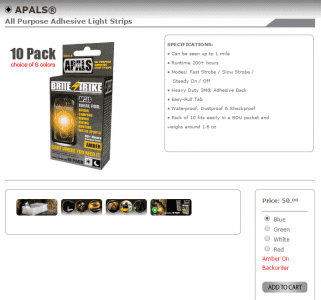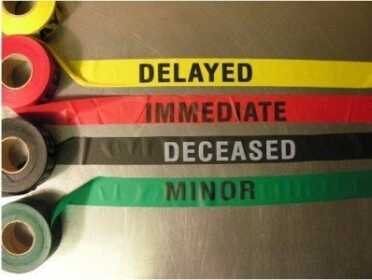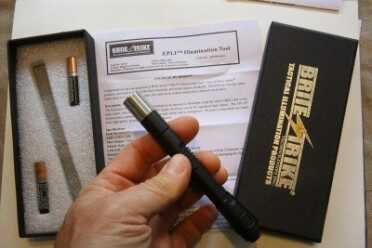
I got the idea for this article from a surprise package from BriteStrike. Their APALS illumination LED pads are great tools for nighttime triage. They are also really useful for camping, trail marking, and nighttime sports.
BriteStrike APALs Outdoor/Trail Marker/Triage Lights $50/10
https://brite-strike.com/oassp.html
Executive Precision Lighting Instrument (ELPI)
Fathers Day Multi-Tool Deal $69
Triage Tape:
On Amazon
On Ebay
What would you do if survival arrived on your doorstep? Would you become part of the rescue effort? Or would you just hunker down and wait to see if the next wave is coming to wipe out the people who did rush in to rescue the survivors of…whatever? I recently got a sample of a really cool product from our friends at BriteStrike, and their multi-colored APALS personal light system made me think about the subject of triage. Back in August I wrote an extremely substantive article on “Survival Medicine,” in which I copied the title of a book you absolutely have to get. My approach is meant to be a compliment to the book, because I go through where you can actually buy stuff. Good intentions and knowledge are great, but you need the tools to do the job. And like everything for this column, I try to find useful stuff on the cheap. These APALS lights are not cheap, $50 for 10 of them, (retailers discount them some) but even if you can only afford the much less expensive alternatives, this is a good chance to talk about triaging the wounded. It is hard to admit to yourself that someday you may have to label someone as “Expectant,” because that means expected to die, but that is the reality we all face.

Please buy the book “Survival Medicine” that is linked in the article. It explains this triage chart, which is called START, and is used by all first responders in the US, though there are more refined versions.
My introduction to triage actually came in the book, “Survival Medicine“. Prior to that I had never considered the subject. He goes through a lengthy explanation of the S.T.A.R.T. (Simple Triage and Rapid Treatment) system which is a mutually agreed system among first responders that determines how quickly a patient should be prioritized. In the book he even gives you examples, then explains how you would triage the individual. The guidelines are really practical, like is the person breathing more than 30 times per minute, or does his fingernail return to pink if you squeeze down in less than 2 seconds? Everyone involved in the rescue attempts should of course be versed in these techniques, and you need some way to mark the people who have already been assessed. First responders carry different colored tapes or cards that correspond to a priority system for mass casualty incidents. The tape colors correspond to:
- Immediate (red)
- Delayed (yellow)
- Walking wounded/minor (green)
- Deceased/Expectant (black)
The APALS lights are pricey, but if you think about it, most **real** bad stuff happens at night. Open field battles, back in the days of muskets and swords, maybe happened at dawn, and for sure all of the fake mainstream media events almost always kick off right after all of the US time zones are awake and have some TVs on. But **real** bad stuff, when it eventually comes to our actually doorsteps, will most likely not be seen on TV, and it will most likely come at night.
If you are a “first responder” after things get messy, self appointed or official, you will absolutely need a good medical pack with lots of bandages, wound sealer, tourniquets, and some sort of triage markers. If there is no serious head or chest wound, you could very well help a bunch of people live out the rest of their lives. I would argue that if you are going to carry just one thing, it would be triage markers, because behind you will be people who know what those colors mean, and they will by training go pick up the people with the red markers first. If it is dark outside, a blinking red light will definitely be the thing that saves that person’s life. I was thinking that maybe if someone is on a budget, they should probably buy the red ones, and tape for the other classifications. That way you can pick your way through the victims and select people who are acute and need attention, but could survive if given quick treatment.

The little lights are $5 each, bought in 10 packs. So they are pricey, but even if you just got red they will compliment your trauma pack more than ten more bandages, or Quickclots. You won’t be alone in helping the wounded.
BriteStrike sent me the green version of their APALS personal lights (of course not red). And as a reviewer, there isn’t much to explain. They are pretty bright, and I think that they would be great for any medical kit anyway, because they are also small lithium battery powered worklights with stickers on them, so as to free up your hands. But as a triage marker, the red, yellow and green lights can’t be mistaken for anything but their intended purpose. You could use the blue or white in place of the black tape, but those are going to be the least pressing people to mark anyway, because they generally won’t be moving or making any sounds. The white lights could also be given out as search and work lights for other people who show up to help. The human eye doesn’t have great night vision, but a little bit of artificial light goes a long way.
APALS can be seen for up to 1/2 mile away at night (over 800 yards). The LED runs for over 80 hours, and they are waterproof to 200 feet. The ten pack comes in a foam case to prevent accidental activation. There are three settings. The first click is fast blink, then slow blink and constant on. The sticker on the back of each APALS uses a heavy duty 3M adhesive. Inside the sealed package is a large lithium button cell and the circuit board to power and flash the surface mount LED. I doubt you could make one of these yourself for less than $5 each. I wish they were rechargeable, but other than that, no complaints about the price.

This triage tape is only Amazon for $24.95, currently backordered, so if you are putting together a trauma pack but the APALS are too much money, seriously think about this tape. I bought some!
There is no escaping that a medical trauma pack is going to be expensive. Go try to find trauma bandages in bulk for less than $5 each. Even expired chest seal bandages are upwards of $10 each. And you can even get military QuickClot bandages, but they are over $10 each. The thing about these APALS is that they are an alternative to chemical light sticks for a lot of tasks, yet they are head and shoulders above light sticks when you look at the cost. Each APALS has up to a 200+ hour runtime, and unlike a chemical light stick, you can turn it off. They also don’t activate by mistake anywhere near as often because the patented flexible package is very well designed. They are also much brighter than lightsticks.
If you are on a budget, I would not buy the ready made trauma packs. You are better to assemble your own pack with things like APALS that you would never find in a premade pack. I bought one of those first and it was lame, and no, it didn’t even come with triage tape let alone any lights. But it also didn’t come with a blood pressure cuff, or even a good tourniquet. You are better off to piece together your own kit, and you can get triage tape printed with the 4 classes of START for $24.95 with free shipping on Amazon, though they appear to have low stock of it. There are other deals on Amazon and Ebay for various different types ranging from $15 to over $100.

This is the EPLI flashlight, which, like the APALs, BriteStrike sent me to review. The button has three levels, bright, less bright, and blink. It will run 30 minutes on high, 6 hours on low, and 45 minutes on strobe. Right now BriteStrike is running a $69 special with a multi-tool for Father’s Day.
Since I get so few things for free for this column and BrightStrike sent me this stuff, I’ll also mention the nifty flashlight that BriteStrike sent me. I put a picture of it here too. They are running a Fathers Day deal on it with a multi-tool right now, so if you are in the market for a high end flashlight for your trauma kit, this might not be a bad option. I am so not a flashlight snob, but I have found that these name brand flashlights can really take a beating, and they are brighter than your average Walmart flashlight. This Executive Precision Lighting Instrument, ie., high quality penlight, is perfect for a trauma kit because it is light and can be clipped on just about anything.
There are so many aspects to survival. All of them cost money. A trauma kit is for helping others, not yourself, and I hate to say it, but that may be the only redeeming possibility when this eventually goes down. None of us may survive, but if we went out helping others, there are worse ways to go.


Quick tip. If you have multiple wounded in the area, shout: LISTEN UP! If you can, get up and come to me, NOW! Everyone who comes to you under their own power, or with minimal assistance from someone else is trudged Green. Hand them a green tag and tell them to continue to where you plan to put minor cases. (Usually, most people involved in a multi-cadualty incident will be part of this group.) Now triage those who could not get to you. You have reduced the time it will take to complete triage to about half of what it would have been. (In the real world, there will always be exceptional situations, so this is not a one size fits all approach. However, it is a good way to accelerate the triage phase of the disaster medical response in many, if not most situations.)
Quick tip. If you have multiple wounded in the area, shout: LISTEN UP! If you can, get up and come to me, NOW! Everyone who comes to you under their own power, or with minimal assistance from someone else is trudged Green. Hand them a green tag and tell them to continue to where you plan to put minor cases. (Usually, most people involved in a multi-cadualty incident will be part of this group.) Now triage those who could not get to you. You have reduced the time it will take to complete triage to about half of what it would have been. (In the real world, there will always be exceptional situations, so this is not a one size fits all approach. However, it is a good way to accelerate the triage phase of the disaster medical response in many, if not most situations.)
So who got paid to put this article on gunsamerica (and in the newsletter twice)? Good advertising, for a rather silly and overpriced product.
Why don’t you actually read the article, and maybe some of the others in this series. Oh, first pull your head out of your ass.
I have the deepest respect for Corpsman and EMS who are the tip of the medical chain. Working in combat, under fire and making life and death decissions is different from formal or hasty designated Triage Areas. Triage by definition is the sorting by priority of the wounded based on time and resource limitations. First aid, ALS and pain management will continue in the Triage Area. Use of these lights in a format Triage is thinking outside the box. In a power out area I could ID and move liters faster then stopping and reading tags every time I came back as the spaces are filled with new wounded arrivals.
I AM A PARAMEDIC ACTIVELY WORKING. THERE HAVE BEEN A MULTITUDE OF TRIAGE KITS OUT THERE MARKETED ALL ARE GEARED FOR THE BIG ONE THE WHOLE IDEA IS AS YOU WALK THE MAYHEM AND DESTRUCTION WITHIN A FEW SECONDS YOU LOOK AT A VICTIM AND DECIDE IF HE IS TO BE SAVED OR PASSED BY NO TREATMENT THAT HAPPENS LATER IF RESOURCES ARE ARRIVING YOU HAVE DONE YOUR JOB IF RESOURCES ARE DELAYED, DESTROYED YOU ARE IT, YOU WILL TRIAGE AGAIN, FOR THOSE THAT ARE SURVIVABLE, EXPECTANT, WALKING WOUNDED, TAKE STOCK OF YOUR SUPLIES AND TREAT THE SURVIVABLE. WITH THIS SAID A MEDICAL PACK SHOULD BE TUNED FOR ONES PERSONAL SURVIVAL, FAMILY MEDICAL PACK TUNED THE SAME. MOST AMBULANCES ARE STOCKED TO TAKE CARE OF SEVERAL PATIENTS AT THE BASIC LEVEL ADVANCED UNITS CARRY DRUGS AND MONITORS RESTOCK DEPENDS ON INFRASTRUCTURE WHICH WON’T BE AROUND A LOT OF SURVIVALIST PUSH FOOD FOOD WEAPONS STORAGE. A SIMPLE CUT CAN GET INFECTED AND LEAD TO DEATH. A MEDICAL SURVIVAL KIT, SOME BASIC TRAINING ON HOW THE BODY WORKS AND KEEP IT WORKING SUCH AS EMT WOULD BE APPROPRIATE. STOCKING UP PEROXIDE ALCOHOL. CHEAP DISINFECTANTS KEEPING UP WITH FAMILY NEEDS ON MEDICINES OVERSTOCK THOSE A LOT OF MEDS EXPIRE BUT ARE STILL GOOD BEYOND SHELF LIFE DEPENDENT ON OW THEY ARE STORED GET SEVERAL MEDICAL BOOKS SUCH AS A MERCY MANUAL THAT HAS BEEN IN THE MEDICAL COMMUNITY FOR YEARS AND COVERS BOO BOOS TO DISEASES SO INDIVIDUALISM ON YOUR MED PACKS WITH YOUR CLOSE ONES IN MIND TO SURVIVE
This is BS! You mark them with either blood, or felt pin on their face if you don’t have a Evac. card with a string attached. I did it this way for two tours of Viet Nam as a Navy medic. Lights? that BS also, half the time you use a light and you will draw rifle mortar fire down on yourself. Use a small red pen light if you have to have a light. I used feel a lot of times to determine the damage. If you had a bad bleeder on the extremities You used the guys belt as a tourniquet until you could find the source of bleeding. With the advent of quick Clot most times you don’t have to go fumbling around with a pair of Hemostats trying to find the artery. Except when you have no other choice. If you are helping out let the EMS guys mark them. The dead ones you have removed to another area out of the way. You have to be operate on a different plane when you do this. Some of the casualties will be children, with mothers crying and distracting you, ignore this! Afterwards you can feel sorry, but your objective is to save as many as you can. You work on the hurried cases first, then the rest. 50 years have gone by since Nam and I still occasionally wake up nights hearing calls for Corpsman UP!.
God bless you, Don & thanks for your tremendous service. Who knows, you might have saved a buddy of mine back then or said a short prayer over on of my other deceased pals.
Pretty sure lots of articles are written by those fresh out of college and having no experience in any other world but the one they’ve lived in with mom and dad. So I guess we’re to break down doors, check everyone out, leave them there and hang a little plastic strip on the door after we reattach it.
I’m getting old and most likely wont last much past my pain management prescriptions any way so they probably will just hang a spare parts tag on my front door for future reference.